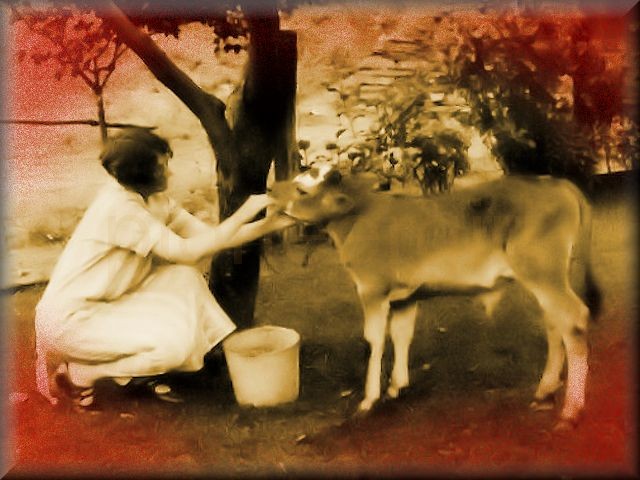poll

The head of a person, or the back part of the head; – sometimes, in composition, applied to the head of a beast. — Webster, 1882
 The wobbly-legged baby calf had been born believing that it must butt hard with its little red poll, to get milk. – Little Town on the Prairie, Chapter 2, “Springtime on the Claim”
The wobbly-legged baby calf had been born believing that it must butt hard with its little red poll, to get milk. – Little Town on the Prairie, Chapter 2, “Springtime on the Claim”
 There were four cows on Noah’s Ark.
There were four cows on Noah’s Ark.
When naturally polled (hornless) cows are bred with any other cow, the offspring are all hornless because the polledness gene is dominant. Unless horned cattle such as Texas Longhorns (see Little House on the Prairie, Chapter 13, “Texas Longhorns”) are a mutation, when the animals went on the ark two by two, there were four cows, one pair with horns, the other polled.
Laura Ingalls Wilder only mentions “polled” cattle once in the Little House books, in Little Town on the Prairie, Chapter 2, “Springtime on the Claim.” Ellen’s calf – and Ellen, obviously – were without horns.
It’s interesting to note that Wilder correctly described both the Scots and the Hispanic way of raising cattle in the Little House books. Sukey was turned loose in clement seasons and brought into a barn or fenced yard to be fed (or fattened for sale or slaughter) once winter set in. In the manuscript for Little House in the Big Woods, Wilder wrote:
The grass was dry and brown and the cows must be taken out of the woods and fed. Pa said Sukey was too old to be kept another year, he must sell her.
The butcher came from town to get her just before milking time when the cows always came home. But old Sukey didn’t come, so Pa told Mary and Laura to go find her in the brush across the road.
They went, but Laura cried and dug her toes in the dust and said she wouldn’t drive Sukey up for the butcher to kill. And when she saw Sukey where she was hiding in the brush she said nothing about it. But Mary saw the cow at last and started her home, while Laura lagged behind, and she cried as the butcher drove Sukey away.
In Scotland, with its cold, short summers, cattle were allowed to roam in mild weather and were winter fed thanks to the introduction of turnips as cattle feed, a crop which the Ingallses also grow for animal feed in the Little House books.
The Hispanic / Texas style of raising cattle was a system without agriculture – no irrigation, no haying, no growing of feed. The animals were left on their own and rounded up for sale or slaughter. Although Wilder mentions cowboys in Little House on the Prairie, there is no mention of cowboys in the manuscript. There are only “strange men herding cattle from Texas north to market.” One wonders if cowboys were added to the story because Laura herself was fond of reading “cowboy stories” as an adult.
In Indian Territory, the Ingallses can hear cattle being herded to Fort Dodge, and Pa is given the gift of a cow and calf. The poor cow is “wild as a deer,” as is to be expected in cattle having minimum human contact.
Charles Ingalls, of course, was used to the Scots method of cattle raising; he built a barn and cut enough buffalo grass for feed during bad weather. Otherwise, the cattle could “mow their own hay” all winter (Chapter 16, “Fire in the Chimney”). He let the cattle fend for themselves, but with only the one cow and one calf, he couldn’t trust them to the Hispanic system of leaving them to range year round.
Apparently, translating Little House on the Prairie into Spanish presented some problems in historical accuracy, because in the years after the Civil War, the Spanish didn’t have a word that meant the same as the American “barn.” They had a choice of words that meant granary, haystack, hay or olive bin, or carriage house. When all else failed, they used cuadra (as in quadrangle), best translated as “that four-sided thing over there.”
While homesteading in Dakota Territory, Charles Ingalls says that he is going to forget farming and raise cattle. “This giving a mortgage on everything he owns, to buy a two-hundred-dollar machine, and paying ten per cent interest on the debt, will ruin a man,” he said. “Let these brash young fellows go into debt for machinery and break up all their land. I’m going to let the grass keep on growing, and raise cattle.” (These Happy Golden Years, Chapter 21, “Barnum and Skip”)
The trouble with open ranging was that it didn’t stand a chance in areas removed from the semi-tropics along the Gulf of Mexico where it originated. The winter after the Ingallses left Indian Territory, 50-75% of cattle already running in open range land in Nebraska and Kansas, died.
And Wilder tells it like it was during the hard winter of 1880-1881, when even larger numbers of local cattle perished in Dakota Territory and elsewhere.

poll (LTP 2)

